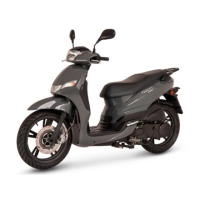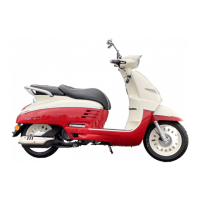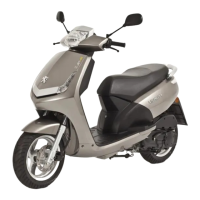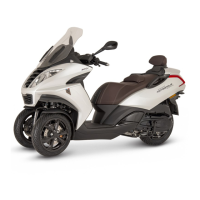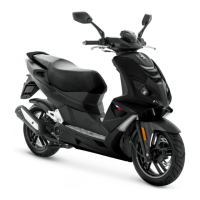Do you have a question about the PEUGEOT KISBEE 50 2021 and is the answer not in the manual?
Official type-approval codes for different models.
Vehicle dimensions including length, width, and height.
Unladen, in-working-order, and maximum authorized weights.
Engine identification number, type, and cubic capacity.
Maximum power, torque, and cooling method.
Fuel supply type, spark plug, lubrication, and exhaust system.
Fuel consumption and CO2 emissions per cycle.
Capacities for engine oil, relay box oil, fuel tank, and fork oil.
Tyre dimensions, load index, and speed rating for front and rear.
Recommended tyre pressures in bars for solo and pillion.
Front suspension type and travel, rear suspension type and travel.
Front and rear brake types and dimensions.
Headlights, side light, indicator, and rear light bulb specifications.
Battery type and specifications.
Location of identification plates and tyre pressure label.
Recommended fuel, engine oil, and other fluids.
Explanations of symbols used in the manual (e.g., Recyclable, Explosive, Flammable).
Meanings of safety, important, and note symbols.
Identification of external components in the first diagram.
Identification of controls and other components in the second diagram.
Explanation of indicators and gauges on the Kisbee panel.
Explanation of indicators and gauges on the Streetzone panel.
Details on speedometer, fuel gauge, and reserve levels.
Explains direction indicator, emissions control, and tripmeter functions.
Operation of lights, horn, indicators, and starter switches.
Functions of ignition switch positions and saddle release.
General checks to perform before riding the vehicle.
Advice for initial use, driving, and safety warnings.
Tips for smooth driving to economize fuel and reduce emissions.
Precautions and guidelines for driving through flood water.
Checklist for fuel, oil, brakes, lights, indicators, horn, wheels, and tyres.
Steps for starting the engine using the starter button.
Steps for starting the engine using the kick-starter.
How to move off after starting the engine.
Control of throttle for acceleration and deceleration.
Brake lever control, technique, and safety precautions.
Safety during fueling and fuel tank location.
Recommended throttle usage during the running-in period.
Engine shut-off and vehicle parking/locking steps.
Maintenance advice, recycling, and battery disposal.
Guidelines for washing and drying the vehicle bodywork.
Spark plug specifications and replacement procedure.
Procedure and interpretation for checking engine oil level.
Steps for draining, cleaning, and refilling engine oil.
Procedure and specification for draining relay box oil.
Steps for removing, cleaning, and fitting a new air filter.
Specification and adjustment of throttle cable play.
Tyre pressure, wear limits, and replacement guidelines.
Inspection of rear lining, front pads, and brake fluid level.
Safety, storage, removal, and installation procedures for the battery.
Fuse ratings, identification of faulty fuses, and replacement procedure.
Steps for replacing headlight, indicator, and rear light bulbs.
Location of the screw for adjusting headlight beam.
Official type-approval codes for different models.
Vehicle dimensions including length, width, and height.
Unladen, in-working-order, and maximum authorized weights.
Engine identification number, type, and cubic capacity.
Maximum power, torque, and cooling method.
Fuel supply type, spark plug, lubrication, and exhaust system.
Fuel consumption and CO2 emissions per cycle.
Capacities for engine oil, relay box oil, fuel tank, and fork oil.
Tyre dimensions, load index, and speed rating for front and rear.
Recommended tyre pressures in bars for solo and pillion.
Front suspension type and travel, rear suspension type and travel.
Front and rear brake types and dimensions.
Headlights, side light, indicator, and rear light bulb specifications.
Battery type and specifications.
Location of identification plates and tyre pressure label.
Recommended fuel, engine oil, and other fluids.
Explanations of symbols used in the manual (e.g., Recyclable, Explosive, Flammable).
Meanings of safety, important, and note symbols.
Identification of external components in the first diagram.
Identification of controls and other components in the second diagram.
Explanation of indicators and gauges on the Kisbee panel.
Explanation of indicators and gauges on the Streetzone panel.
Details on speedometer, fuel gauge, and reserve levels.
Explains direction indicator, emissions control, and tripmeter functions.
Operation of lights, horn, indicators, and starter switches.
Functions of ignition switch positions and saddle release.
General checks to perform before riding the vehicle.
Advice for initial use, driving, and safety warnings.
Tips for smooth driving to economize fuel and reduce emissions.
Precautions and guidelines for driving through flood water.
Checklist for fuel, oil, brakes, lights, indicators, horn, wheels, and tyres.
Steps for starting the engine using the starter button.
Steps for starting the engine using the kick-starter.
How to move off after starting the engine.
Control of throttle for acceleration and deceleration.
Brake lever control, technique, and safety precautions.
Safety during fueling and fuel tank location.
Recommended throttle usage during the running-in period.
Engine shut-off and vehicle parking/locking steps.
Maintenance advice, recycling, and battery disposal.
Guidelines for washing and drying the vehicle bodywork.
Spark plug specifications and replacement procedure.
Procedure and interpretation for checking engine oil level.
Steps for draining, cleaning, and refilling engine oil.
Procedure and specification for draining relay box oil.
Steps for removing, cleaning, and fitting a new air filter.
Specification and adjustment of throttle cable play.
Tyre pressure, wear limits, and replacement guidelines.
Inspection of rear lining, front pads, and brake fluid level.
Safety, storage, removal, and installation procedures for the battery.
Fuse ratings, identification of faulty fuses, and replacement procedure.
Steps for replacing headlight, indicator, and rear light bulbs.
Location of the screw for adjusting headlight beam.
| Engine Type | Single cylinder, 4-stroke |
|---|---|
| Engine Stroke | 4-stroke |
| Displacement | 49.9 cc |
| Cooling System | Air cooled |
| Fuel System | Carburetor |
| Transmission | Automatic |
| Front Suspension | Telescopic fork |
| Front Brake | Disc |
| Rear Brake | Drum |
| Front Tire | 110/70-12 |
| Rear Tire | 110/70-12 |
| Fuel Capacity | 6.5 liters |
| Seat Height | 780 mm |
| Max Torque | 3.2 Nm @ 6, 750 rpm |
| Rear Suspension | Mono shock absorber |
